If “easy to ride”, “lightweight”, and “great color options” are important criteria for your child’s 20 inch bike, the Frog 52 and Frog 55 should be high on your list. Both 20 inch, 8-speed hybrid bikes, the Frog 52 is slightly smaller than the Frog 55, allowing you to purchase a bike that is the most ideal fit for your growing child.
With trigger shifters, a low, flat handlebar, and knobby, all-terrain tires, these 20 inch Frog Bikes are ideal for confident and adventurous riders who are ready to tackle paved and dirt trails on their first geared bike. But how do the Frog 52 and Frog 55 compare to other high-end kids’ bike brands? We’ll cover that in detail in our review below.
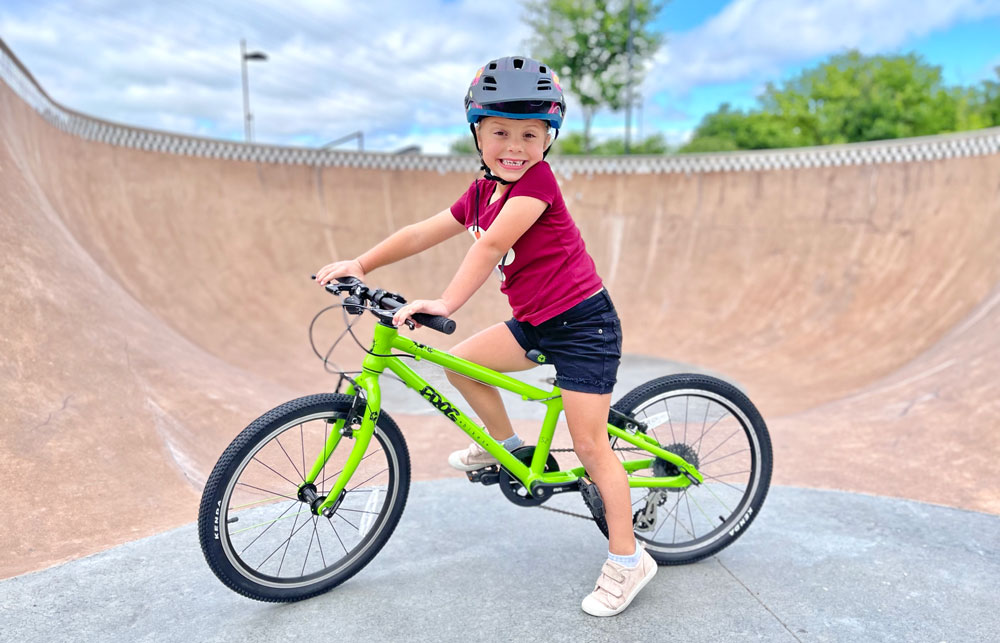
Frog 52 and Frog 55 Overview

RATING: Highly Recommended
MSRP: $570 (Frog 52), $580 (Frog 55)
BEST FOR: Confident and adventurous riders on paved and mild dirt trails
SPECIFICATIONS
SEAT HEIGHT: (Frog 52) 22″ – 27.5″, (Frog 55) 23.7″ – 29″
WEIGHT: 18.7 lb. (Frog 52), 18.9 lb. (Frog 55)
FRAME: Aluminum Alloy
GEARS: 8-speed, Shimano Altus
BRAKES: Tektro Dual Hand Brakes
GAIN RATIO: (Frog 52) 2.5 – 6.6, (Frog 55) 2.2 to 5.9
TIRES: Kenda Hybrid 20 ×1.5
PROS:
- Super lightweight – one of the lightest 20″ bikes on the market
- Offered in two sizes for a more accurate fit
- Seven different color options!
- Narrow q-factor for more comfortable pedaling
- All-terrain tires provide traction on a wide variety of surfaces
- High-quality Tektro v-brakes
- Wider, cushioned saddle comfy for little bums
CONS:
- Higher bottom bracket limits ideal leg extension
- Trigger shifters a little more difficult to engage than other 20″ bikes in this price range
Frog 52 and 55 – Results of our Test Rides
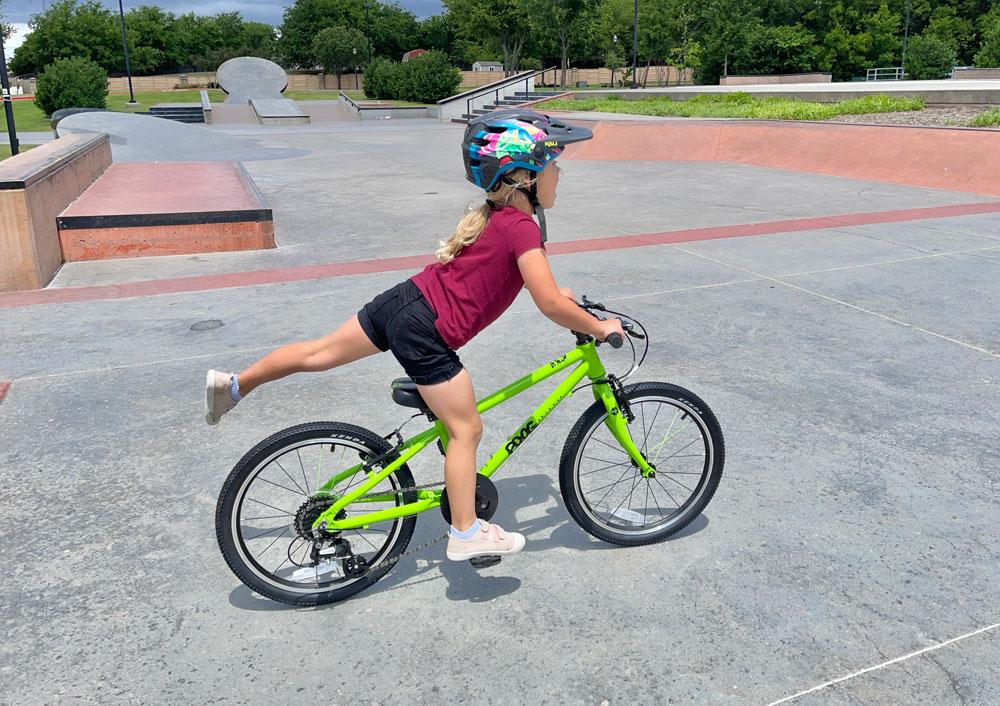
Hailing out of the UK, Frog Bikes was one of the early pioneers in transforming the kids’ bike market from a load of clunky, hard-to-ride bikes, into a select group of bikes that are lightweight and kid-friendly in design.
While still not widely known in the US, we have tested (and loved!) several Frog Bikes over years, but this is our first chance to test a 20″ model. The bike seen throughout this review is the Frog 52, but we’ll also cover the Frog 55, which is also a 20″ bike, but a slightly larger version.
Why a Frog 52 or 55? – Weight and Color Options

In the online kids bike market, there are a handful of exceptional 20″ bikes that all offer kid-specific geometry to make riding a bike as fun and easy as possible. So why might you buy a Frog over other high-end kids’ bikes?
While there are more nuances we’ll discuss below, the Frog 52 and 55’s two biggest selling points in the marketplace are weight and color options.
Color Options
SEVEN color options! When a kid just has to have an orange bike or a pink bike or a polka dotted bike, Frog Bikes to the rescue. Frog has more color options than any other high-quality, kids’ bike brand out there. They also frequently have limited-time color options, including yellow for the Tour de France or Union Jack flag.
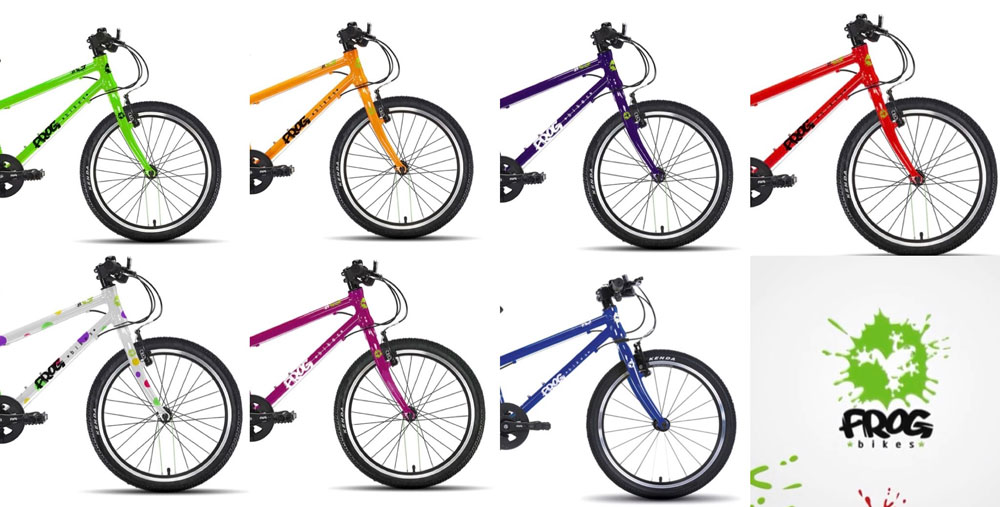
Weight
Frog Bikes has always placed a strong emphasis on keeping the weight down, and actually markets the brand as “the lightweight kids bike”. The Frog 52 weighs in at 18.7 pounds (with pedals), which makes it one of the lightest 20″ bikes on the market.
Making a lightweight 20″ bike with gears requires the use of expensive and often custom parts, which is why cheap kids bikes are so heavy. For example, the Schwinn Koen 20″ bike weighs 26 pounds… and doesn’t have gears! That’s a lot of additional weight for a child that only weighs 45 to 55 pounds themselves.
The Frog 52 is lighter than most other higher-end 20″ geared bikes. At 18.7 pounds, it’s lighter than the Prevelo Alpha Three (19.1 pounds), Guardian Airos (21.2 pounds), and Priority Start (19.5 pounds). The woom 4 is slightly lighter at 17.9 pounds.
Geometry Best for Confident or Adventurous Riders

With a low, flat handlebar, the Frog 52 and 55 are best-suited for confident riders who love to lean in for speed and explore every adventure your neighborhood, local dirt trails, pump track, or skate park has to offer. Aggressive riders thrive on this style of bike.
If your child is more on the timid side, they will likely prefer a higher-rise handlebar that keeps their hands higher and their body more upright. If this sounds like your child, the woom 4 would be a great alternative.
In this collage below, you can see how our rider is slightly more upright on the woom (blue bike), and her hands are higher in relation to her waist.

Higher Bottom Bracket Limits Leg Extension
The collage above demonstrates an additional aspect of the Frog 52’s geometry – the higher- than-average placement of its bottom bracket (for bikes in its price range). The bottom bracket is the part of the frame where the crank arms attach to the bike (the crank arms rotate around the bottom bracket).
The high bottom bracket of the Frog plays a large role in creating a more cramped position for the child’s knee at the high stroke (when the pedal is straight up on the bike). As you can see here, the rider’s knee bend is tighter on the green Frog than on the blue woom 4, with the seat heights is set to match.
Frog 52 More Cramped at the High Stroke

While seemingly minor, this tighter knee bend makes it more challenging (and therefore less efficient) for the child to exert force back down on the pedal.
On the flip side, at the bottom of the pedal stroke shown below, the child isn’t able to fully extend their leg to get the most out of their pedal stroke.
Frog 52 Less Leg Extension at Low Stroke

Typically, raising the seat quickly solves this issue, but in this case, if the seat were to be raised any higher, she wouldn’t have been able to touch the ground when stopped.
This issue will manifest primarily when a child is riding with the saddle at or within about an inch of the seat height minimum, as the child is doing above. As the child grows and the seat can be raised an inch or two, the child’s pedal stroke will become more efficient.
How does this play out in real life? While it’s difficult (impossible) to get a meaningful response from a 4-year-old, we did notice that she tends to stand up to pedal on this bike more than she does on other bikes.
Handlebar is More Narrow than Other Bikes
Compared to similar “aggressive” bikes like the Prevelo Alpha Three and the Cleary Owl, it’s important to note that the handlebar is more narrow on the Frog 52 and 55. It’s about 3.5″ shorter than the Prevelo and 2.5″ shorter than the Cleary.
The Frog’s handlebars are still plenty wide for your average neighborhood and paved trail rider, but if you’re planning on using this bike for mild single track, you may want to swap out the bar for a wider one.
Q Factor – How does it Compare?
Frog Bikes places a big emphasis on q-factor, which is the distance between the pedals. Before Islabike, woom, and Frog came along, kids’ bikes had notoriously wide q-factors, forcing kids to splay their legs out uncomfortably in order to pedal the bike.
Bikes with a narrow q-factor, like the Frog 52 and 55, place the pedals more directly under a child’s hips. This allows them to push straight down on the pedals for a more comfortable and efficient stroke.
We measured the Frog 52’s q-factor against the woom 4 and the Prevelo Alpha Three, which are both known for their narrow q-factors. The Frog 52’s q-factor was right on par.
Longer Chainstays
Another unique feature of the Frog 52 and 55 (as well as most Frog bikes) is their longer chainstays. The chainstay is the portion of the frame that runs between the chain connecting the rear wheel of the bike to the bottom bracket.

While most kids on a 20″ bike won’t notice the difference, a longer chainstay does make the bike less “playful”. Popping up the front wheel to do a bunny hop or turning through a tight switchback won’t come as naturally on a Frog, but at this age, the differences will be minor.
The benefit of a longer chainstay is that it makes the bike more stable at higher speeds as well as better centers the child’s weight between the two wheels.
Size – Which Frog 20 inch bike is a good fit for my rider?
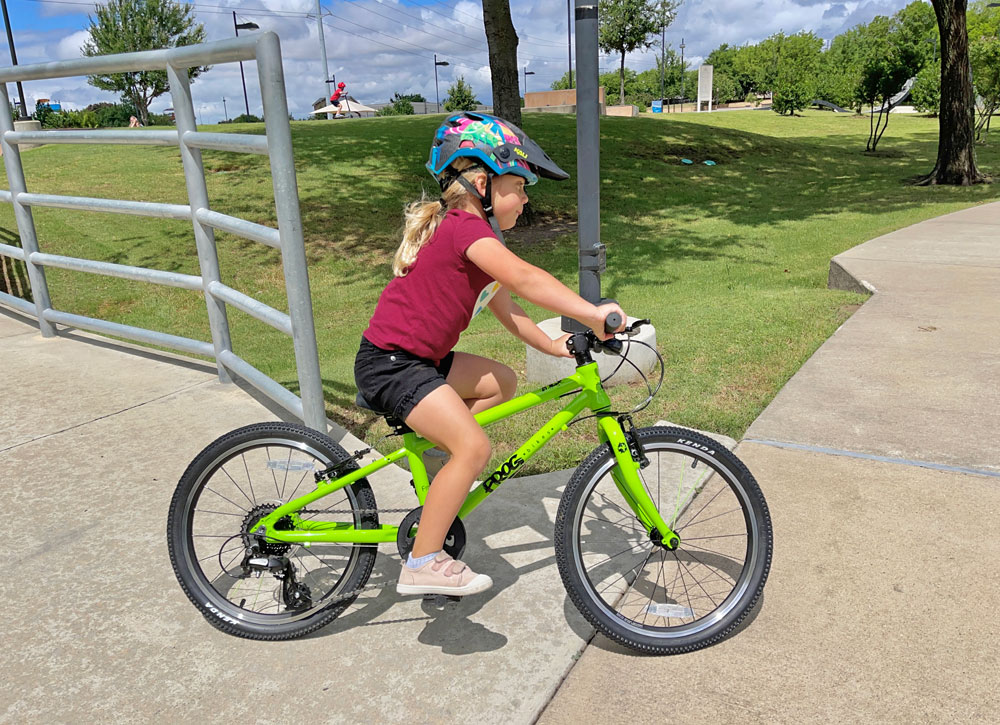
Frog 20 inch bikes are offered in two sizes. The Frog 52 and the slightly larger Frog 55.
The Frog 52 has a seat height range of 22″ to 27.5″. The Frog 55 has a seat height range of 23.7 – 29″.
Experienced pedal bike riders on a 20″ bike typically ride with the saddle set 2 – 3″ above their inseam. As a reference point, the girl rider seen in this review is 45″ tall and has a 19.75″ inseam with shoes on.
If your rider’s inseam is between 19″ and 20.5″, the Frog 52 would be the appropriate fit. If your rider has an inseam greater than 20.5″, the larger Frog 55 would be more appropriate.
To learn more about finding the best bike fit for your child, check out our guide on proper bike sizing.
Important Note: Frog Bikes’ website states that the stem of the Frog 52 and 52 can be lowered or raised within a range of 54mm. However, the bike is shipped with all of its stem spacers already below the stem. As a result, you could lower the handlebars if you wanted to, but not raise them unless you purchased a stem riser or riser handlebars.

While aggressive and adventurous kids tend to prefer lower and flatter handlebars for optimal maneuvering, a child will outgrow a bike with a flat bar faster than a bike with mid-rise handlebars or a handlebar that can be rotated or raised as a child grows. (The woom 4’s unique handlebar is designed specifically for this purpose.)
Our 7-year-old tester is 52.5″ tall and has a 23.5″ inseam. The saddle is set to 25.8″ in the image below. While he can certainly still ride the bike, the low handlebar is becoming less ideal at his height.
53.5″ Rider on the Taller Range for the Frog 52

Try On at a Local Bike Shop
Most boutique, high-end kids bikes that we recommend are only available online. Frog Bikes are unique because they have become available in an increasing number of local bike shops. If you’d like to test for a great fit before you buy and support your local bike shop, click here for their bike shop locator.
Shimano Derailleur and Gearing Range
A Shimano Altus derailleur (a step-up from Shimano’s base-level Tourney line) shifts smoothly through its 8 gears. The Frog 52 and 55 also feature a derailleur hanger, which greatly helps to prevent potential damage to the derailleur.

With a gain ratio of 2.5 to 6.6 for the Frog 52 and 2.2 to 5.9 for the Frog 55, the gearing is on par with other 20″ bikes in its price range. The higher range on the smaller Frog 52 is due to shorter crank arms than the Frog 55.
(The lower the gain ratio, the easier it is to pedal… think climbing up hills. The higher the gain ratio, the harder it is to pedal, but you can gain and maintain more speed on flat roads and downhill.)

The gearing range provided by the Frog 20″ bikes is more than sufficient for most kids, but isn’t quite as wide as the Prevelo Alpha Three’s 2.0 to 6.7 provided by 9 gears. Very few kids this age will find a true benefit outside of the Frog’s range, unless they need a lower gear for prolonged uphill climbs or a higher gear for long descents.
The woom 4’s gain ratio range is 2.3 to 5.9, almost identical to the Frog 55.
Trigger Shifters

Instead of the more common grip shifters found on most kids’ bikes, the Frog 52 and 55 feature double-thumb trigger shifters. We prefer trigger shifters for their smoother and faster shifting, but they aren’t as intuitive as a grip shifter when first learning gears. (Woom 4 has grip shifters.)
We have found that confident, coordinated, and athletic kids are able to pick up the motion of pushing the trigger buttons fairly quickly. But if your child is more on the timid or less-coordinated side, a grip shifter would likely be an easier introduction to gears.
The Frog’s proprietary triggers were updated in 2019 to decrease the distance a child has to push the lever to downshift. It also features a numbered window to help kids gauge what gear they are in. (Numbers 1, 4, and 8 are displayed.) Not all trigger shifters have this window, and riders are required to change gears strictly on feel.
While a numbered window isn’t necessary for more advanced riders, it is certainly a bonus for kids just learning the art of shifting. It also makes it easier for parents who are riding alongside them to help make sure they are in the appropriate gear.
For tips on teaching young kids to use trigger shifters, you can read all about that here.
It’s important to note that not all trigger shifter buttons are created equal. Some are easier to engage than others. We found the Frog 52’s downshift trigger button (larger lever) requires slightly more force to push than the corresponding trigger shifter button on the Prevelo Alpha Three. (Prevelo’s shifter is Microshift while Frog’s is Frog-branded.)
Our 4.5-year-old rider has been using trigger shifters on the Prevelo for six months but had a tougher time engaging the downshift on the Frog 52.
This is particularly important with young riders who have limited hand strength due simply to their age. If your child is tall and thus transitioning to a 20″ bike when they are still 4 or barely 5, learning to use the Frog 52’s trigger shifters may be more challenging.
Tektro V-Brakes

High-quality Tektro v-brakes are pretty standard for high-end neighborhood and multi-use kids’ bikes. They are engaged by easy-reach, easy-pull, kid-friendly brake levers and offer solid stopping power, which quickly instills confidence in riders.

As an added bonus, the soft, rubberized grips you see in the image above are exceptionally comfortable for little hands.
All-Terrain Tires and Mudguards
The Kenda 20 x 1.5″ tires offer a multi-use tread that is knobby enough for great traction on mild dirt trails, but also smooth enough to roll quickly and quietly over pavement.

For families who live in wetter climates, the included mudguards will come in handy. But unless you plan on riding in wet or muddy conditions fairly regularly, we would recommend not installing them as they add about a pound of unnecessary weight to the bike if they aren’t needed.
Frog Bikes have a minor but helpful feature to help simplify the process of pumping those tires. The two wheel spokes that flank the air valve are bright green, making it super easy to find the valve quickly.

That said, the rims on the Frog 52 are deeper than on other kids bikes, which makes it challenging to attach a pump to the valve because not as much valve is exposed. Parents will probably need to be involved with tire pumping.
Super Comfy, Railed Saddle

The Frog 52 and 55’s saddle is nicely cushioned, offering a bit more padding than similar bikes. The rear of the saddle is also wider than bikes like the woom 4 or Prevelo Alpha Two, which some kids may find more comfortable on their sit bones over long periods of time.
The seat height is easily adjusted with a quick release collar, and the saddle can move forward or backward on its rails to make minor body position adjustments.
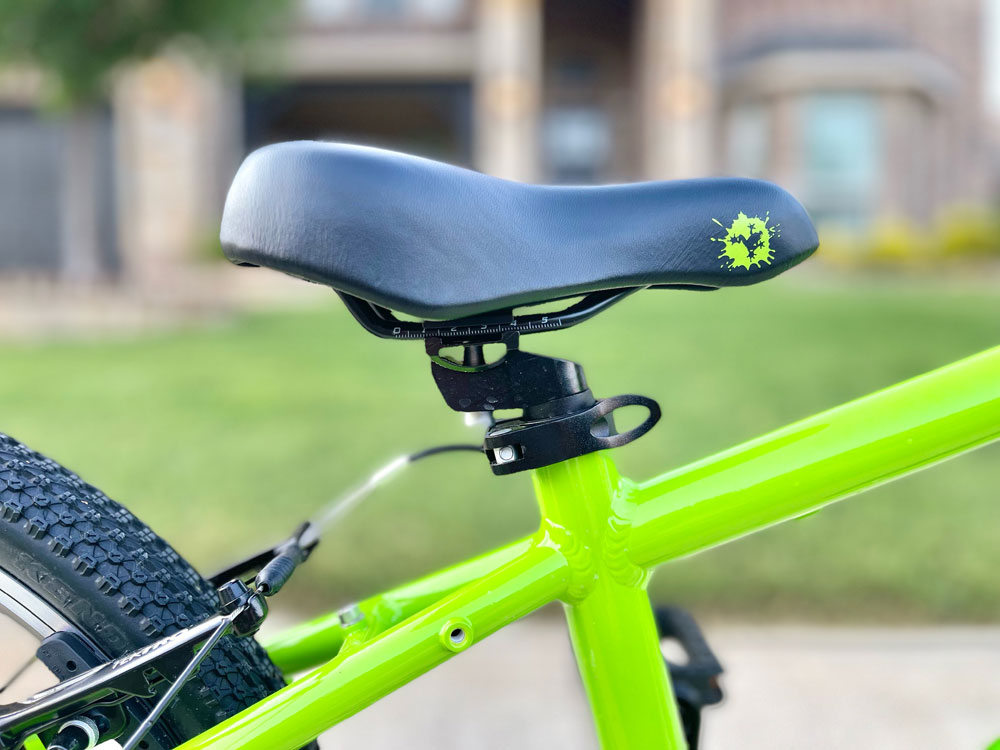
Frog 52 vs. Other Lightweight 20″ Bikes
In the world of lightweight kids bikes, the Frog 52 is a solid competitor when compared to similar bikes like the woom 4 or Prevelo Alpha Three. But while its price is higher, the quality and design are not better than a woom or Prevelo.
Having tested over a hundred kids bikes, we can confidently say that the Frog 52 is one of the best 20 inch bikes out there, but the only truly compelling reason to pay more than for a woom or Prevelo are the Frog’s fun and varied color options.
Because the Frog 55 is the largest of the 20″ options here, if you’re looking for an aggressive bike with trigger shifters, it is larger than the Prevelo Alpha Three and would offer more room for growth for a taller child.
| Bike | Frog 52 | Frog 55 | Prevelo Alpha Three | woom 4 |
|---|---|---|---|---|
| MSRP | $570 | $580 | $539 | $599 |
| Seat Range | 22" - 27.5" | 20.75" - 25.75" | 20.75" - 25.75" | 22.1" - 27" |
| Brakes | Dual Hand | Dual Hand | Dual Hand | Dual Hand |
| Gearing | 8-speed, Trigger | 8-speed, Trigger | 9-speed, Trigger | 7-speed, Grip |
| Weight | 18.7 lb. | 18.9 lb. | 19.1 lb. | 17.9 lb. |
| Gain Ratio | 2.2 - 5.9 | 2.0 - 6.7 | 2.0 - 6.7 | 2.3 - 5.9 |
| Read our Review | You're reading it! | You're reading it! | Prevelo Alpha Three | woom 4 |
Frog 52 and 55 Bottom Line
Kids bikes don’t get much better than a Frog Bike. With super kid-friendly geometry for an easy and natural ride, a lightweight frame, and a rich palette of colors to choose from, the Frog 52 or Frog 55 might just be the bike to make your kid’s biking dreams come true.
The higher price tag of the Frog may be a bit much for many families, especially considering its main benefit over its closest competitors is visual styling and color options rather than any functional benefit.
FTC Disclosure: Affiliate links are included in this review. No monetary compensation was provided for this review, however, the reviewed product was supplied by the manufacturer or distributor to help facilitate this review. All opinions and images are that of Two Wheeling Tots LLC. All content and images are copyrighted and should not be used or replicated in any way. View our Terms of Use.
